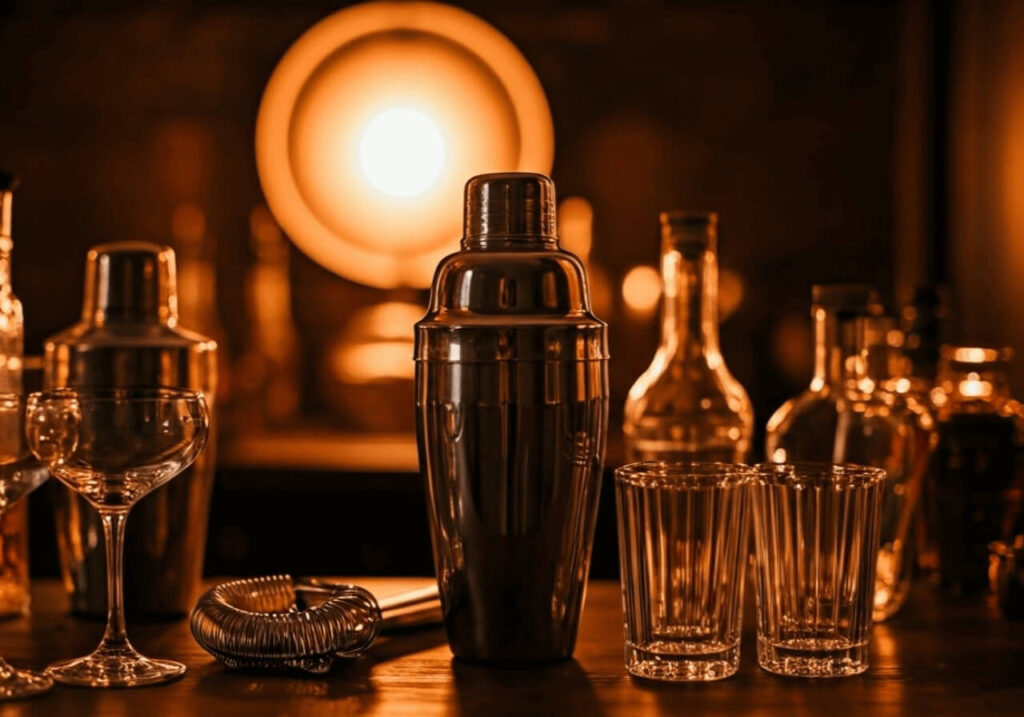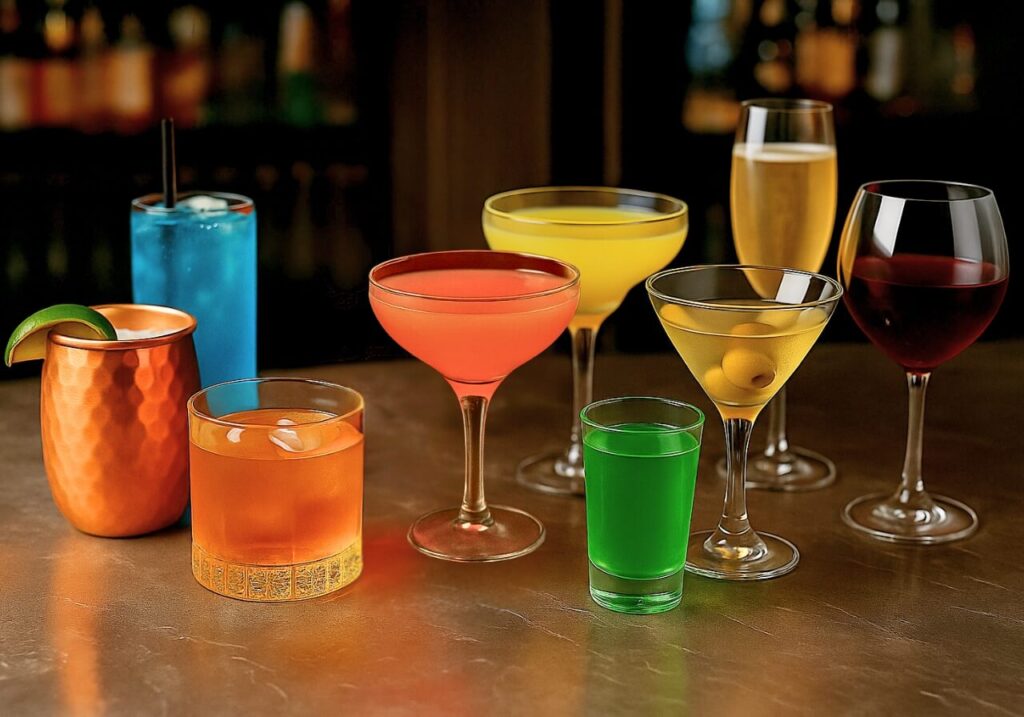Affiliate disclaimer: This post contains links to products to help cover the costs of running this website. There's no extra cost to you, and we only recommend products that we think are awesome. Thanks for your support!
Cocktail shakers are more than just tools, they’re an essential part of the art and science of mixology. Whether you’re a seasoned bartender or a home enthusiast, understanding the ins and outs of cocktail shakers can elevate every drink you craft. In this comprehensive guide we’ll delve into the history, types, techniques, and care of cocktail shakers, providing everything you need to know about shaking up a perfect cocktail every time.
Our Top Picks
We’ve selected a few standout cocktail shakers for you, which have earned high praise for their durability, design, and performance.
Best Cobbler Shakers
- Stainless steel
- Leak-proof seal
- Parts are easy to separate
- Cap also functions as a jigger with printed measurement markings
- Capacity: 24oz
Best Boston Shakers
Best Parisian Shakers
- Elegant contour
- Highly polished stainless steel
- Generous capacity, perfect for batch cocktails
- Includes built-in cap & strainer
- Amazing gift for any cocktail lover, home bar owner, and for any party
The Art and Legacy of Cocktail Shakers
A Brief History
The cocktail shaker has a history that reflects the evolution of cocktails themselves. Initially emerging in the 19th century, shakers were born from the need to efficiently blend ingredients while chilling and diluting spirits to perfection. Early bartenders discovered that vigorous shaking not only mixed the flavors seamlessly but also added an appealing froth to certain drinks. Over time, different shaker designs evolved to suit both professional and home bartending, making them indispensable in bars around the world.
Cocktail Shakers: A Symbol of Mixology
Today, the cocktail shaker stands as a symbol of creativity and craft. It’s the centrepiece of many home bars and a trusted companion in bustling nightclubs and sophisticated cocktail lounges alike. Its dual purpose — both as a mixing vessel and a performance piece — captures the essence of the cocktail-making experience. The right shaker can transform an ordinary evening into a memorable event, encouraging both experimentation and refinement.
Why Shaking Matters
In mixology, the method of combining ingredients can drastically affect the taste, texture, and presentation of a cocktail. Shaking, when done correctly, achieves several key outcomes:
- Proper Mixing: Ensures that all the ingredients — from spirits and liqueurs to juices and syrups — combine uniformly.
- Controlled Dilution: Ice not only chills but also dilutes the cocktail just enough to balance strong flavors without watering them down.
- Texture and Emulsification: For drinks that incorporate fruit purees, creams, or egg whites, shaking creates a smooth, frothy consistency that enhances both appearance and mouthfeel.
Mastering this technique is essential for any bartender. When executed with precision, shaking transforms a simple combination of ingredients into a symphony of flavors.
Exploring Different Types of Cocktail Shakers
There isn’t a one-size-fits-all solution when it comes to cocktail shakers. Each style offers distinct advantages, and choosing the right one can depend on your personal preference, experience level, and the types of cocktails you most frequently craft.
Boston Shaker
Overview:
The Boston shaker is a two-piece system typically consisting of a metal tin and a mixing glass or a second tin. It’s favored by professional bartenders for its versatility and capacity.
Advantages:
- Capacity: Often larger than other types, allowing you to mix multiple servings at once.
- Control: Offers a more tactile experience, giving you better control over the intensity of the shake.
- Speed: Its simplicity makes it a favorite for quick, efficient mixing.
Considerations:
While the Boston shaker offers a professional edge, it may require a bit more practice to master the seal between the two pieces, preventing spills during vigorous shaking.
Cobbler Shaker
Overview:
The cobbler shaker is a three-piece set that includes a metal tin, a built-in strainer, and a cap. It’s widely recommended for home bartenders and those new to mixology.
Advantages:
- User-Friendly: The built-in strainer simplifies the process, making it easier to pour your cocktail without ice or fruit pulp.
- Design: Its compact design is both functional and visually appealing.
- Convenience: Ideal for making single servings or cocktails that don’t require multiple pours.
Considerations:
The extra piece (the cap) can sometimes trap air, potentially affecting the dilution rate. Additionally, some users find the cap cumbersome when preparing multiple drinks.
French Shaker (AKA Parisian Shaker)
Overview:
The French shaker is similar to the Boston style but typically comprises two tins of equal size. It’s known for its sleek design and is a favorite among modern mixologists.
Advantages:
- Aesthetics: Its clean lines and balanced design make it a stylish addition to any bar.
- Performance: Offers the same benefits as the Boston shaker in terms of capacity and mixing efficiency.
- Versatility: Suitable for both professional and home use, especially if you appreciate a minimalist design.
Considerations:
Like the Boston shaker, mastering the seal is crucial. It may also require more attention to detail to ensure a spill-free shake.
How to Choose the Right Cocktail Shaker for You
Assessing Your Needs
Before purchasing a cocktail shaker, consider your mixology style and the environment in which you’ll be using it. Ask yourself:
- Frequency of Use: Are you a casual home bartender or do you frequently host parties?
- Cocktail Preferences: Do you lean towards recipes that require vigorous shaking, or are you more inclined to stir drinks?
- Ease of Use: Would you prefer a user-friendly, all-in-one option, or are you comfortable with a more professional tool that might require a learning curve?
Material Matters
Cocktail shakers are available in a variety of materials, each offering unique benefits:
- Stainless Steel: The most common choice, prized for its durability, ease of cleaning, and sleek look. Stainless steel shakers are resistant to corrosion and maintain a consistent chill.
- Glass: Often used in certain Boston shaker setups, glass can add a touch of elegance but may be more fragile.
- Plastic or Composite Materials: While less common among purists, these can be useful for outdoor or casual use where durability is a concern.
Price and Quality
Investing in a high-quality cocktail shaker can make a significant difference in your mixology journey. Professional-grade shakers, while sometimes more expensive, offer enhanced performance, durability, and aesthetics. Consider reading reviews and comparing brands to find a shaker that balances cost with quality.
Mastering the Shake: Step-by-Step Guide
Creating the perfect cocktail isn’t just about the ingredients, it’s about technique. Here’s a concise, friendly walkthrough:
1. Gather Your Ingredients and Tools
- Ingredients: Measure your spirits, liqueurs, juices, and any other components precisely.
- Ice: Fresh, high-quality ice is key to achieving the right dilution and chill.
- Shaker: Whether you choose a Boston, cobbler, or French shaker, ensure it’s clean and ready for use.
- Strainer: If your shaker doesn’t include one, have a fine strainer handy to catch any ice shards or fruit pulp.
2. Build Your Cocktail
- Measure and Pour: Follow your recipe closely by adding the ingredients to the shaker. Precision is essential to maintain balance in the cocktail.
- Add Ice: Fill the shaker with ice to about two-thirds full. Too little ice may result in insufficient chilling, while too much can over-dilute your drink.
3. Seal and Shake
- Seal: Secure the two parts of your shaker firmly. For cobbler shakers, place the cap on correctly.
- Shake: Hold the shaker with both hands, one on each side, and shake vigorously. Aim for a smooth, controlled motion rather than wild flailing. The goal is to create a frothy mix that integrates all the flavors. Generally, a good shake lasts about 10–15 seconds.
4. Strain and Serve
- Open Carefully: Once your shake is complete, remove the cap (if using a cobbler shaker) or separate the tins carefully.
- Strain: Use the built-in strainer or a separate one to pour your cocktail into a glass, ensuring a smooth finish free of ice shards.
- Garnish: Finally, add any garnish as indicated by your recipe. A citrus twist, a sprig of mint, or even a decorative stirrer can elevate the presentation.
Shaking vs. Stirring: When to Use Each Technique
Understanding the Differences
Mixologists often debate the merits of shaking versus stirring, and the choice can dramatically affect the outcome of a cocktail.
- Shaking:
- Benefits: Ideal for cocktails containing citrus juices, dairy, egg whites, or other non-spirit ingredients. Shaking quickly chills and dilutes the cocktail while also incorporating air, resulting in a frothy texture.
- Best For: Margaritas, daiquiris, and sours, where a well-emulsified, frothy consistency is desired.
- Stirring:
- Benefits: Provides a gentle mix that preserves the clarity and silky texture of cocktails made primarily of spirits and liqueurs. Stirring minimizes dilution and prevents over-aeration.
- Best For: Martinis, Manhattans, and other spirit-forward cocktails where clarity and a smooth mouthfeel are paramount.
Choosing the Right Technique
The decision largely depends on the cocktail’s composition:
- Ingredients: If your recipe includes delicate or opaque ingredients, shaking is typically the way to go.
- Desired Texture: For a light, frothy texture, shaking works best. If you’re aiming for a silky, clear finish, stirring is preferable.
- Personal Preference: Ultimately, your taste and style will dictate which technique feels more intuitive and satisfying.
Expert Tips and Tricks for Perfect Cocktail Shaking
Embrace the Technique
- Practice Makes Perfect: The more you shake, the more you’ll develop an instinct for the right intensity and duration. Experiment with different speeds and motions until you find what works best for you.
- Don’t Overdo It: Over-shaking can result in a cocktail that’s too diluted. Keep an eye (and ear) on your shake duration—typically, 10 to 15 seconds is ideal.
Optimize Your Tools
- Invest in Quality: A well-made cocktail shaker not only performs better but also feels more balanced and comfortable in your hand.
- Keep it Clean: Residue from previous cocktails can affect the flavor of new drinks. Regular cleaning is a must for maintaining both taste and hygiene.
Experiment with Garnishes
A well-chosen garnish isn’t just decorative—it can enhance the aroma and flavor of your cocktail. Whether it’s a twist of lemon, a dash of bitters, or a sprig of herbs, don’t underestimate the finishing touch.
Temperature Control
Using freshly made, high-quality ice ensures that your cocktail chills properly without unwanted dilution. For those serious about mixology, consider investing in ice molds that produce large, slow-melting cubes.
Caring for Your Cocktail Shaker: Maintenance and Cleaning
Maintaining your cocktail shaker is crucial for longevity and performance. Here are some essential tips to keep your shaker in tip-top shape:
Daily Cleaning
- Rinse Immediately: After each use, rinse your shaker with warm water to remove any residue before it has a chance to dry.
- Soap and Water: Use a mild dish soap and a non-abrasive sponge to gently scrub all parts of your shaker. Pay special attention to any crevices where ingredients might hide.
- Dry Thoroughly: After washing, dry your shaker completely to prevent water spots or rust (especially if it’s stainless steel).
Deep Cleaning
- Occasional Soak: For stubborn stains or sticky residues, soak your shaker in a solution of warm water and vinegar for about 15 minutes before scrubbing.
- Avoid the Dishwasher: While some cocktail shakers may be labeled as dishwasher safe, hand washing is usually recommended to maintain the finish and prevent any damage over time.
Storage Tips
- Keep It Dry: Store your shaker in a dry place to avoid moisture buildup.
- Separate Pieces: If possible, store the components separately to ensure that no residual moisture is trapped inside.
Conclusion
Investing in a quality cocktail shaker is an investment in your mixology journey. Whether you’re preparing for a quiet night in or hosting a lively gathering, the right shaker can make all the difference. From understanding the nuances of shaking versus stirring to choosing the best type of shaker for your needs, every detail contributes to the overall experience of crafting the perfect cocktail.
Remember, great mixology isn’t solely about following recipes, it’s about experimenting and refining techniques, and adding your personal touch. With the insights provided in this thorough guide you now have a solid foundation to unlock endless creative possibilities. Cheers to great cocktails and memorable moments! 🍸✨
Frequently Asked Questions
1. What’s the difference between a Boston shaker and a cobbler shaker?
The Boston shaker is a two-piece system (tin and mixing glass or two tins) favored by professionals for its capacity and control, while the cobbler shaker is a three-piece set that includes a built-in strainer and cap, making it ideal for home bartenders and beginners.
2. When should I shake my cocktail versus stirring it?
Shake cocktails that include citrus, dairy, egg whites, or other emulsifying ingredients to achieve a frothy texture. Stir spirit-forward cocktails like Martinis or Manhattans to preserve clarity and a smooth consistency.
3. Can I use any type of ice in my cocktail shaker?
Fresh, high-quality ice is key. Larger, denser cubes are ideal as they melt slower, ensuring your drink is chilled without becoming overly diluted.
4. How long should I shake a cocktail?
Typically, a vigorous shake lasting about 10 to 15 seconds is sufficient. Over-shaking can lead to excessive dilution.
5. Is it important to clean my cocktail shaker regularly?
Absolutely. Regular cleaning prevents residue buildup that can alter the flavor of your cocktails and ensures that your shaker remains in optimal condition.
Next Up: The 10 Must-Have Bar Tools Every Home Bartender Needs
Now that you’ve got the shaker down, why stop there? From jiggers to muddlers, our comprehensive guide covers all the must-have bar tools that’ll make mixing drinks at home easier, and way more fun. Check it out!
👉 Must-Have Bar Tools: 10 Essentials Every Home Bartender Needs
The Party Starter Kit gathers all our favorite finds — from clever cocktail gadgets to the behind-the-scenes tools that keep this site running smoothly. Take a peek, it’s all in there.

Mimosa Blaze is your go-to gal for cocktails, bar tips, and party vibes. She’s all about easy mixes, clever hacks, and making every gathering unforgettable. Cheers to good times!












